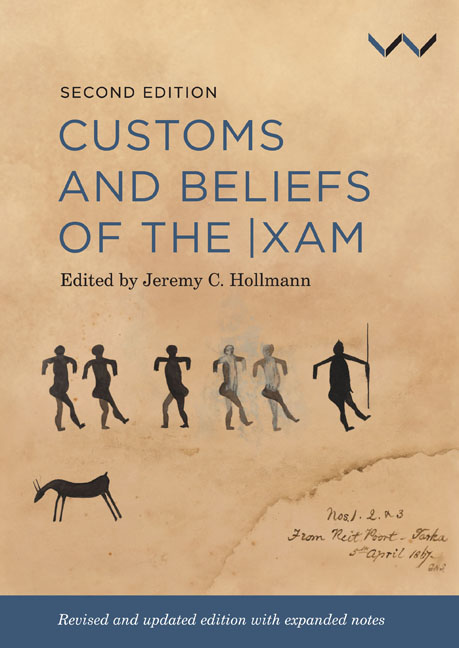Book contents
- Frontmatter
- Dedication
- Contents
- Acknowledgements
- Foreword To The Second Edition
- Foreword To The First Edition
- Introduction
- Contributors
- The |Xam Language
- The People In The Notebooks
- Part 1 Baboons
- Part 2 The Lion
- Part 3 Game Animals
- Part 4 Omens, Windmaking, Clouds
- Part 5 Rain
- Part 6 Rainmaking
- Part 7 Sorcerers
- Part 8 More About Sorcerers and Charms
- Part 9 Special Speech of Animals and Moon
- Appendix 1 |Xam Grammar
- Appendix 2 Summary of The Narratives
- References
- Index
Appendix 1 - |Xam Grammar
Published online by Cambridge University Press: 24 November 2023
- Frontmatter
- Dedication
- Contents
- Acknowledgements
- Foreword To The Second Edition
- Foreword To The First Edition
- Introduction
- Contributors
- The |Xam Language
- The People In The Notebooks
- Part 1 Baboons
- Part 2 The Lion
- Part 3 Game Animals
- Part 4 Omens, Windmaking, Clouds
- Part 5 Rain
- Part 6 Rainmaking
- Part 7 Sorcerers
- Part 8 More About Sorcerers and Charms
- Part 9 Special Speech of Animals and Moon
- Appendix 1 |Xam Grammar
- Appendix 2 Summary of The Narratives
- References
- Index
Summary
The |Xam material recorded in the late nineteenth century by Wilhelm H.I. Bleek and Lucy C. Lloyd is still a source of general and academic fascination for many today, particularly for its folkloric, anthropological, and linguistic interest. Perhaps surprisingly, the language itself received relatively little attention after the death of the Bleek family members involved in this research. Therefore, it is all the more fortunate that Dorothea F. Bleek's (1928–1930) grammar sketch, one of the few linguistic documents on this language, is republished here.
The classification of Xam
The foraging peoples of southern Africa, commonly known as ‘San’ (or ‘Bushmen’), comprise many different groups distinguished from one another by, among other things, the languages they speak. This is contrary to the widespread assumption that they form a homogeneous population. Their languages belong to three language families, which have not been shown to be genealogically related to each other, namely Khoe-Kwadi, Kx’a, and Tuu (see Güldemann 2014). The groundwork for the establishment of these three groups ultimately derives from Dorothea Bleek's (for example, 1927) pioneering research, and her groupings of ‘Central Bushman’, ‘Northern Bushman’, and ‘Southern Bushman’, respectively.
|Xam belongs to the ǃUi group, whose speakers were distributed over most of South Africa and Lesotho. ǃUi is a branch of the Tuu family, whose other major branch, Taa- Lower Nossob, is found in central-eastern Namibia and south-western Botswana. Only one ǃUi language, which Dorothea Bleek called ‘N‖ng’ but which is today also known under the name of a major dialect, ‘N|uu’, has survived to the present day. It is now spoken by less than a handful of old people in the Northern Cape, north of the Gariep (Güldemann 2017).
|Xam was the language of San groups who lived in the arid interior of the Cape, to the south and west of the Gariep. Recent research suggests that |Xam – or at least groups speaking closely related language varieties – was also spoken by inhabitants on both sides of the river itself, from its upper course in the Free State down to its lower course forming the border with Namibia (see, for example, Güldemann 2006). However, it remains unclear how far the distribution of |Xam speakers extended into areas closer to the coast where the dominant language varieties were from Khoekhoe (Khoe-Kwadi).
- Type
- Chapter
- Information
- Customs and Beliefs of the |xam , pp. 505 - 540Publisher: Wits University PressPrint publication year: 2022



